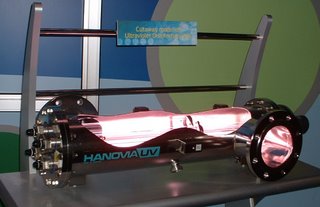Australians have been actively talking about municipal water recycling and desalination for a couple of years now. Many people have been interested enough to find out about one of the most touted technologies for these processes, being reverse osmosis (RO). For a very quick refresher on the general principal of RO you might like to skim through my previous post on seawater desalination.
RO has the potential to clean almost any water to practically any quality we may desire. However, there are two major limitations to RO. The first is considerable energy requirement to force saline water through a semi-permeable membrane against an osmotic pressure pushing in the opposite direction. The second is the production of large volumes of concentrated brine which must somehow be disposed of.
Researchers at Yale University (USA) are working on a novel potential answer to these limitations. Rather than working against the osmotic pressures of RO, Prof Menachem Elimelech proposes a concept that makes the osmotic pressure his ally. The process is called forward osmosis (FO).
Unlike RO, the driving force for FO separation is osmotic pressure, not hydraulic pressure. By using a concentrated solution of high osmotic pressure called the “draw solution”, water can be induced to flow from contaminated or saline water across a semipermeable membrane, leaving the dissolved contaminants behind. The (now diluted) draw solution can then be reconcentrated, yielding purified water and a “draw solute” ready to be recycled in a closed loop.
 Identifying suitable draw solutions is currently the largest obstacle to the successful large-scale implementation of FO water treatment. Ideally, draw solutes should be those that can be easily chemically or thermally precipitated from solution for removal. Some researchers have proposed the use of dissolved gases that can be removed by thermal means, or the use of larger molecular weight solutes that can be separated by physical means.
Identifying suitable draw solutions is currently the largest obstacle to the successful large-scale implementation of FO water treatment. Ideally, draw solutes should be those that can be easily chemically or thermally precipitated from solution for removal. Some researchers have proposed the use of dissolved gases that can be removed by thermal means, or the use of larger molecular weight solutes that can be separated by physical means.An ideal draw solute would have a high solubility, a low molecular weight, and a way of easily being removed from the water. High solubility coupled with low molecular weight allows for the generation of large osmotic pressures which lead to high product water transport across the membrane and high purified water recoveries (ie. minimal brine volumes). The ability to be easily removed from the water is crucial since the overwhelming majority of the energy used in the FO process is for draw solute recovery.
Ideas for using FO for water purification processes have been around for some time and a small number of studies have been published since the mid-1970s. Furthermore, a number of patents have been awarded, but none of these have really matured or proven practical for implementation. Interestingly, the US space agency NASA is currently investigating FO for direct potable reuse of wastewater in advanced life support systems for space applications.
One draw solution currently being investigated is composed of ammonium salts which are formed when ammonia and carbon dioxide gases are mixed in water. Once the concentrated draw solution is used to effect separation of water from the feed source, the subsequently diluted draw solution may be treated thermally to remove the ammonium solutes, producing purified water as the primary product.
This thermal separation of draw solutes is based on the useful characteristic of these ammonium salts to decompose back into ammonia and carbon dioxide gases when the solution is heated. If the process is done under vacuum, the necessary applied temperature can be as low as 40°C, meaning that low grade “waste heat” from other industrial processes may be a viable energy source.
However, current methods for fully recovering the ammonia and carbon dioxide gases from the product water are still relatively inefficient and still render the overall process relatively energy-intensive. Therefore, further improvements are required for draw-solute recovery to improve the overall viability of FO for large-scale implementation.
Any good ideas?


